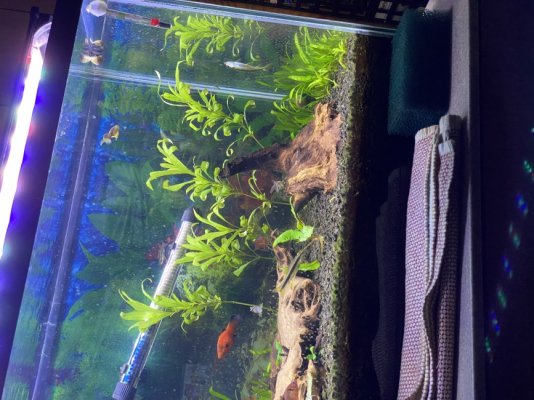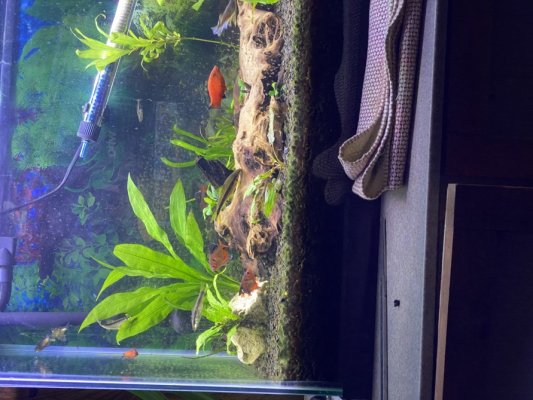DC634
Aquarium Advice Apprentice
Hey All,
I have been having issues trying to figure out what is wrong in my planted tank. I am hoping that someone here can help me out. My tank info is:
29 gallon tank with eco complete substrate (4" thick)
I run a Beamswork DA Full spec for about 7 hours a day
Ammonia: 0
Nitrite: 0
Nitrate: 30
Phos: 1.5
pH: 7.4
GH: 5
KH: 13
Ca: 5dCa : 25ppm
50% water change every weekend
I dose:
NilocG - 2 Bottle formula with Macro and Micro (I can provide link or values it adds if desired)
2 pumps each bottle a week (seems low but it gets me to the Nitrate Values I wanted)
Florish Potassium: 10-12 ml a week
Excel: 6ml a day
DIY O+ root tabs under root feeding plants
I just started a week and half ago using seachem equilibrium at 1 Table spoon after water change(1x week)
The plants that are having issues are mostly the Hygrophila and cryps.
The Hygrophila's old leaves have a major downward curl to them, it looks like a major calcium deficiency but my Ca value is at 25ppm. From what I read you want from 20-30ppm so I should be fine there. And my java fern just is not getting big and bushy like it should. The leaves keep turning black and dieing off. Seems to be doing better past couple weeks. I see decent new growth. Also, my crypts leaves just look all kinds of deformed (new and old). They also have a reddish hue to them (not sure if that's normal or not). I started using seachem equilibrium to see if it is just an imbalance of Ca:Mg but not seeing much different. I also have some algae growing on the glass. It grows in spots and real hard to get off. I have to scrape it with a razor or credit card to get it to come off. I have included pictures of the plants for reference.
I know its a waiting game but I figured I would ask some of yall for your ideas or tips.
I have been having issues trying to figure out what is wrong in my planted tank. I am hoping that someone here can help me out. My tank info is:
29 gallon tank with eco complete substrate (4" thick)
I run a Beamswork DA Full spec for about 7 hours a day
Ammonia: 0
Nitrite: 0
Nitrate: 30
Phos: 1.5
pH: 7.4
GH: 5
KH: 13
Ca: 5dCa : 25ppm
50% water change every weekend
I dose:
NilocG - 2 Bottle formula with Macro and Micro (I can provide link or values it adds if desired)
2 pumps each bottle a week (seems low but it gets me to the Nitrate Values I wanted)
Florish Potassium: 10-12 ml a week
Excel: 6ml a day
DIY O+ root tabs under root feeding plants
I just started a week and half ago using seachem equilibrium at 1 Table spoon after water change(1x week)
The plants that are having issues are mostly the Hygrophila and cryps.
The Hygrophila's old leaves have a major downward curl to them, it looks like a major calcium deficiency but my Ca value is at 25ppm. From what I read you want from 20-30ppm so I should be fine there. And my java fern just is not getting big and bushy like it should. The leaves keep turning black and dieing off. Seems to be doing better past couple weeks. I see decent new growth. Also, my crypts leaves just look all kinds of deformed (new and old). They also have a reddish hue to them (not sure if that's normal or not). I started using seachem equilibrium to see if it is just an imbalance of Ca:Mg but not seeing much different. I also have some algae growing on the glass. It grows in spots and real hard to get off. I have to scrape it with a razor or credit card to get it to come off. I have included pictures of the plants for reference.
I know its a waiting game but I figured I would ask some of yall for your ideas or tips.


